Contemporary Financial and Integrated Reporting Article Review
VerifiedAdded on 2022/09/14
|9
|1777
|23
Report
AI Summary
This report critically reviews a research article that examines the relevance of integrated reporting to sell-side analysts. The article's objective is to determine whether the information in integrated reports is useful to analysts, considering the growing importance of integrated reporting for disclosing both financial and non-financial information. The review explores the research questions, methodology (semi-structured interviews with analysts), and findings, which suggest that integrated reports are largely irrelevant to analysts due to biases and barriers in information gathering. The report also discusses the implications of these findings for stakeholders such as the IIRC, analysts, and preparers of integrated reports, emphasizing the need for the IIRC to engage with the analyst community and improve the information content of integrated reports to better serve their decision-making needs. Finally, the review identifies limitations in the research methodology and its potential impact.
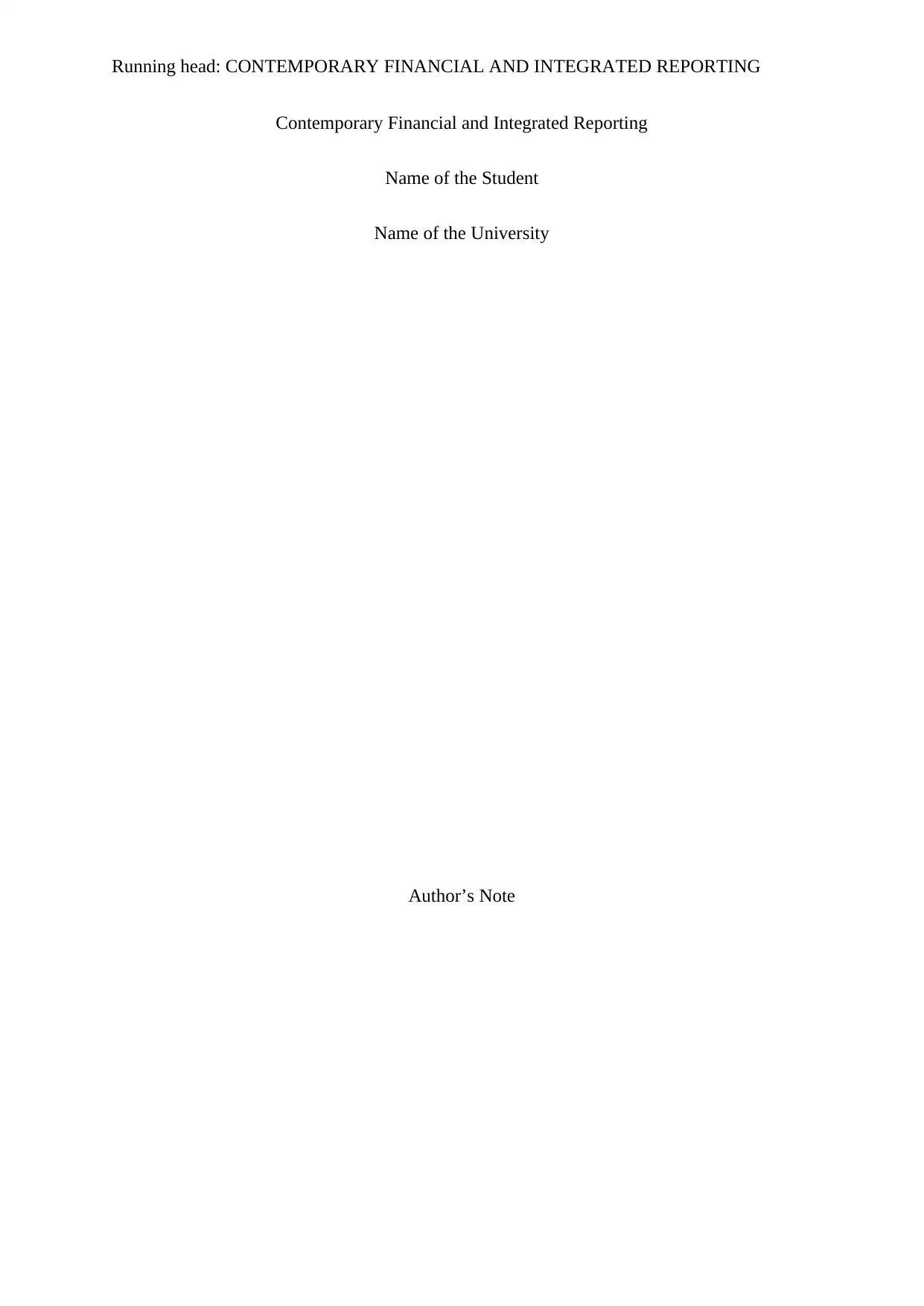
Running head: CONTEMPORARY FINANCIAL AND INTEGRATED REPORTING
Contemporary Financial and Integrated Reporting
Name of the Student
Name of the University
Author’s Note
Contemporary Financial and Integrated Reporting
Name of the Student
Name of the University
Author’s Note
Paraphrase This Document
Need a fresh take? Get an instant paraphrase of this document with our AI Paraphraser
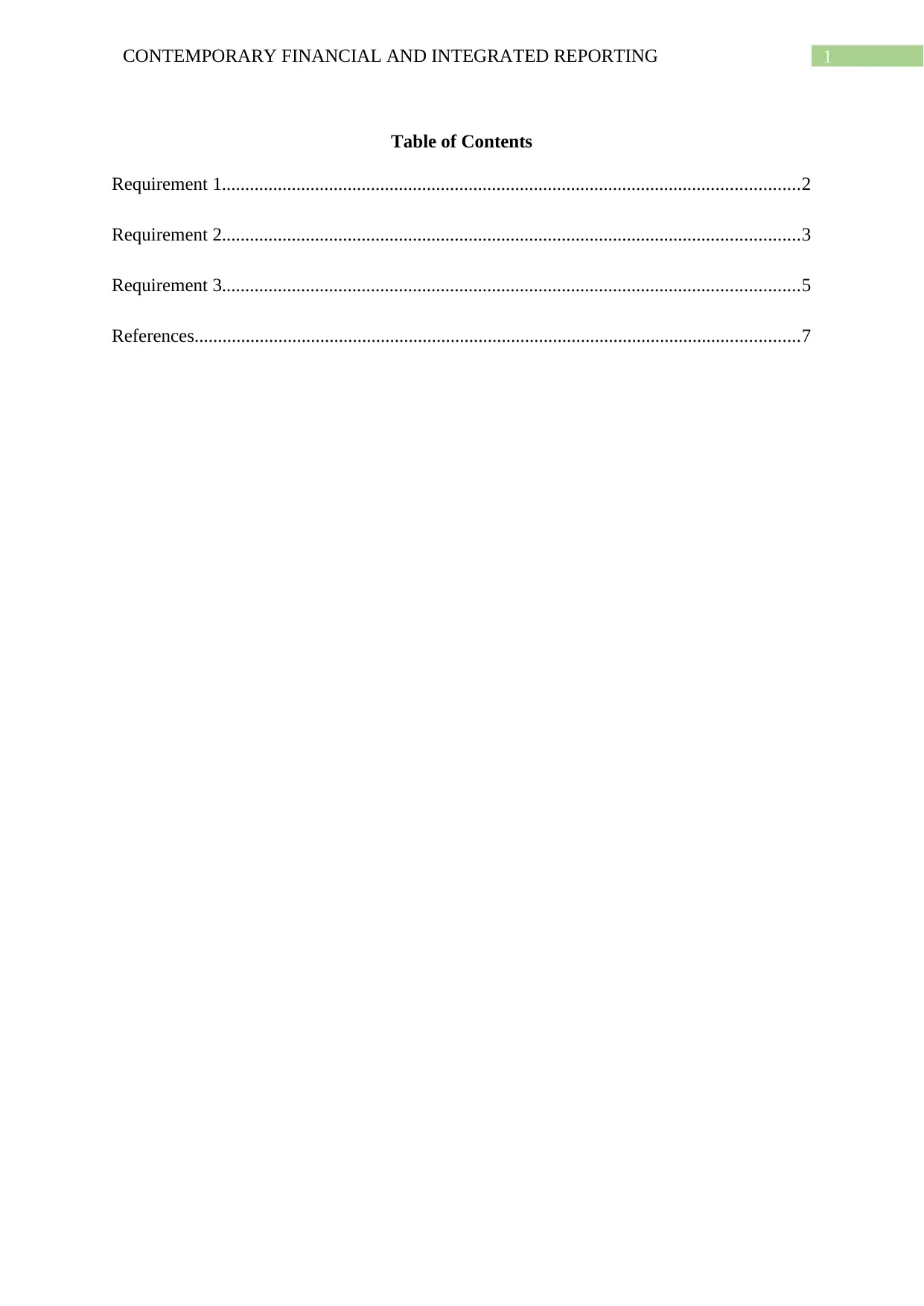
1CONTEMPORARY FINANCIAL AND INTEGRATED REPORTING
Table of Contents
Requirement 1............................................................................................................................2
Requirement 2............................................................................................................................3
Requirement 3............................................................................................................................5
References..................................................................................................................................7
Table of Contents
Requirement 1............................................................................................................................2
Requirement 2............................................................................................................................3
Requirement 3............................................................................................................................5
References..................................................................................................................................7
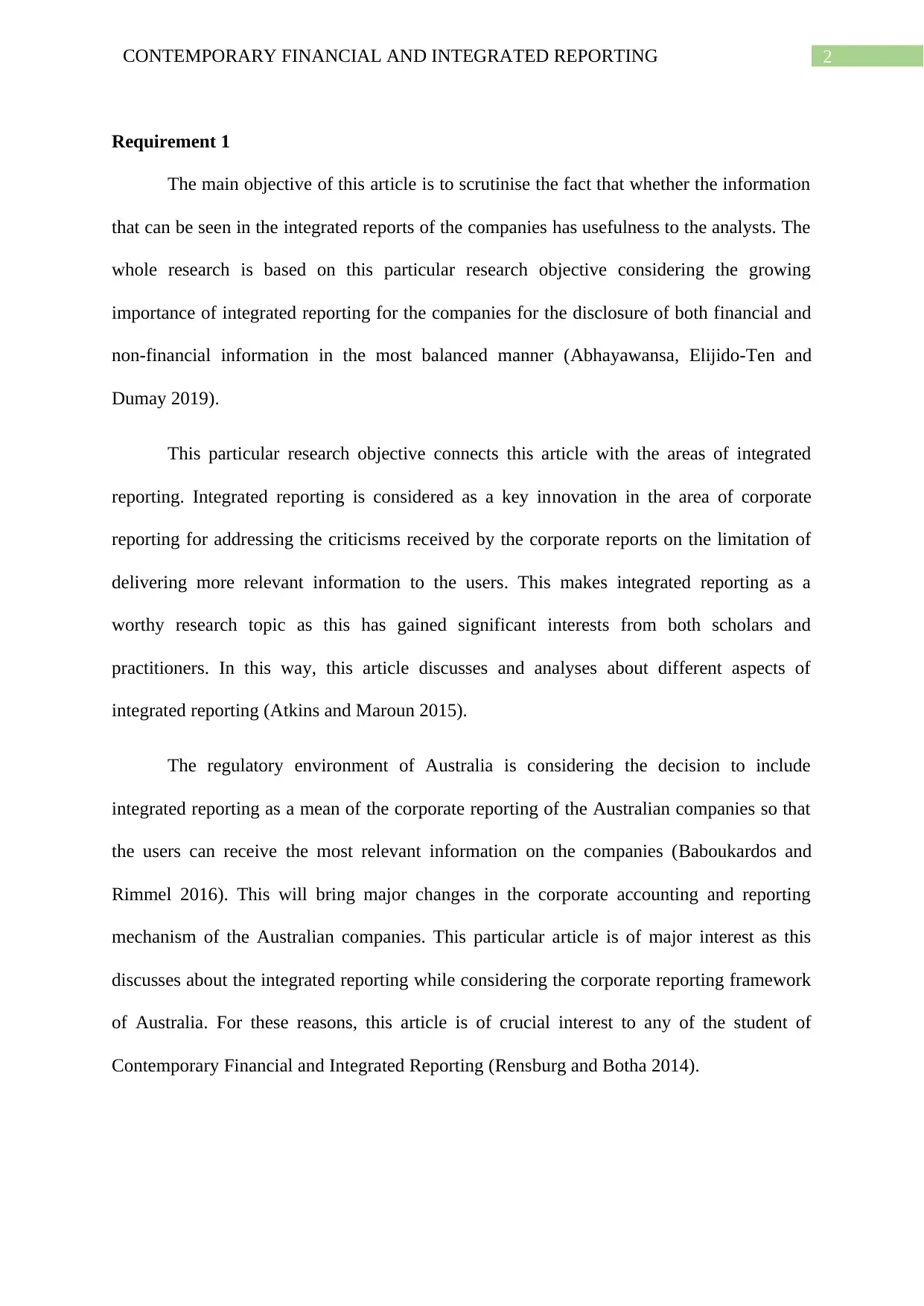
2CONTEMPORARY FINANCIAL AND INTEGRATED REPORTING
Requirement 1
The main objective of this article is to scrutinise the fact that whether the information
that can be seen in the integrated reports of the companies has usefulness to the analysts. The
whole research is based on this particular research objective considering the growing
importance of integrated reporting for the companies for the disclosure of both financial and
non-financial information in the most balanced manner (Abhayawansa, Elijido‐Ten and
Dumay 2019).
This particular research objective connects this article with the areas of integrated
reporting. Integrated reporting is considered as a key innovation in the area of corporate
reporting for addressing the criticisms received by the corporate reports on the limitation of
delivering more relevant information to the users. This makes integrated reporting as a
worthy research topic as this has gained significant interests from both scholars and
practitioners. In this way, this article discusses and analyses about different aspects of
integrated reporting (Atkins and Maroun 2015).
The regulatory environment of Australia is considering the decision to include
integrated reporting as a mean of the corporate reporting of the Australian companies so that
the users can receive the most relevant information on the companies (Baboukardos and
Rimmel 2016). This will bring major changes in the corporate accounting and reporting
mechanism of the Australian companies. This particular article is of major interest as this
discusses about the integrated reporting while considering the corporate reporting framework
of Australia. For these reasons, this article is of crucial interest to any of the student of
Contemporary Financial and Integrated Reporting (Rensburg and Botha 2014).
Requirement 1
The main objective of this article is to scrutinise the fact that whether the information
that can be seen in the integrated reports of the companies has usefulness to the analysts. The
whole research is based on this particular research objective considering the growing
importance of integrated reporting for the companies for the disclosure of both financial and
non-financial information in the most balanced manner (Abhayawansa, Elijido‐Ten and
Dumay 2019).
This particular research objective connects this article with the areas of integrated
reporting. Integrated reporting is considered as a key innovation in the area of corporate
reporting for addressing the criticisms received by the corporate reports on the limitation of
delivering more relevant information to the users. This makes integrated reporting as a
worthy research topic as this has gained significant interests from both scholars and
practitioners. In this way, this article discusses and analyses about different aspects of
integrated reporting (Atkins and Maroun 2015).
The regulatory environment of Australia is considering the decision to include
integrated reporting as a mean of the corporate reporting of the Australian companies so that
the users can receive the most relevant information on the companies (Baboukardos and
Rimmel 2016). This will bring major changes in the corporate accounting and reporting
mechanism of the Australian companies. This particular article is of major interest as this
discusses about the integrated reporting while considering the corporate reporting framework
of Australia. For these reasons, this article is of crucial interest to any of the student of
Contemporary Financial and Integrated Reporting (Rensburg and Botha 2014).
⊘ This is a preview!⊘
Do you want full access?
Subscribe today to unlock all pages.

Trusted by 1+ million students worldwide
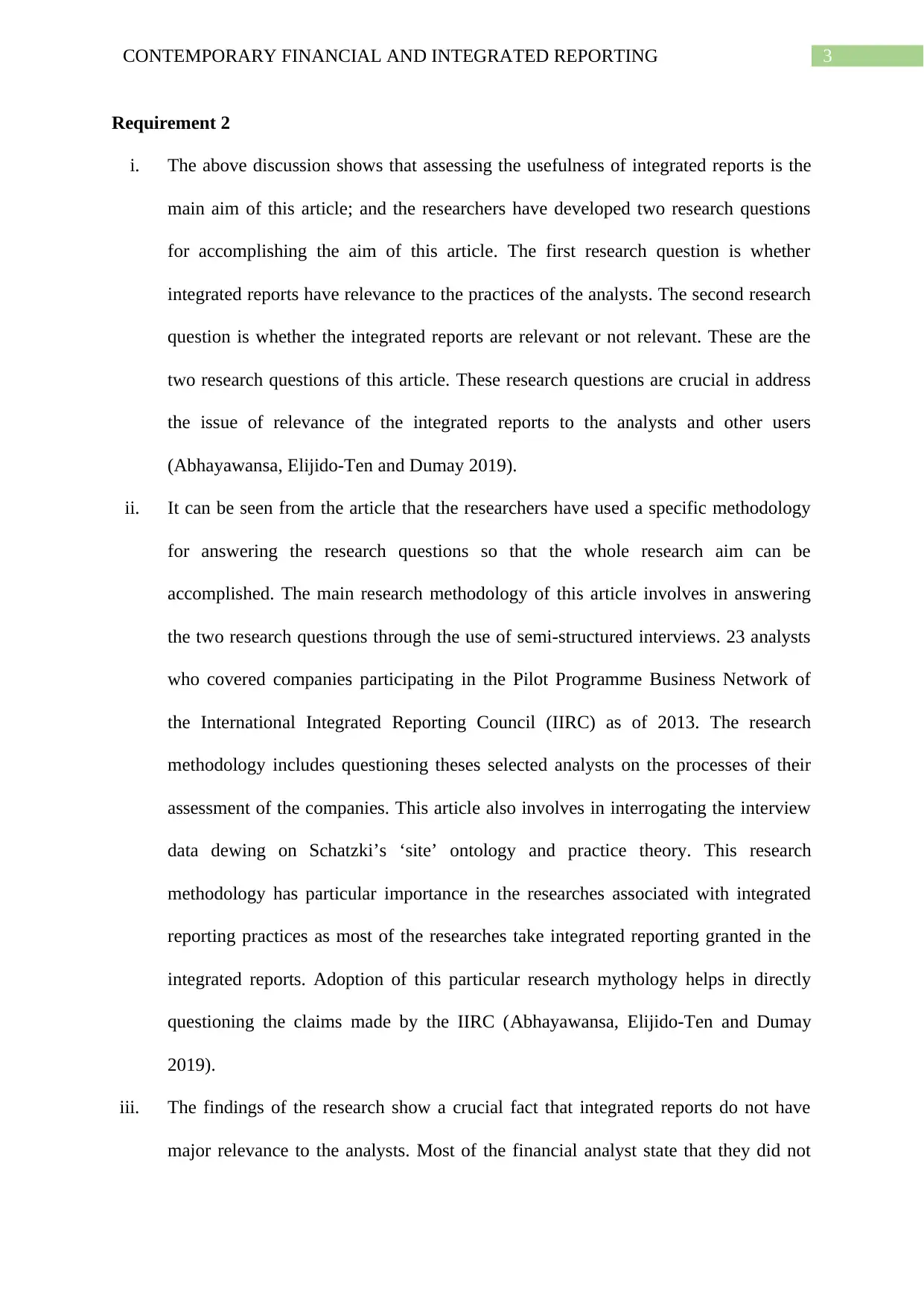
3CONTEMPORARY FINANCIAL AND INTEGRATED REPORTING
Requirement 2
i. The above discussion shows that assessing the usefulness of integrated reports is the
main aim of this article; and the researchers have developed two research questions
for accomplishing the aim of this article. The first research question is whether
integrated reports have relevance to the practices of the analysts. The second research
question is whether the integrated reports are relevant or not relevant. These are the
two research questions of this article. These research questions are crucial in address
the issue of relevance of the integrated reports to the analysts and other users
(Abhayawansa, Elijido‐Ten and Dumay 2019).
ii. It can be seen from the article that the researchers have used a specific methodology
for answering the research questions so that the whole research aim can be
accomplished. The main research methodology of this article involves in answering
the two research questions through the use of semi-structured interviews. 23 analysts
who covered companies participating in the Pilot Programme Business Network of
the International Integrated Reporting Council (IIRC) as of 2013. The research
methodology includes questioning theses selected analysts on the processes of their
assessment of the companies. This article also involves in interrogating the interview
data dewing on Schatzki’s ‘site’ ontology and practice theory. This research
methodology has particular importance in the researches associated with integrated
reporting practices as most of the researches take integrated reporting granted in the
integrated reports. Adoption of this particular research mythology helps in directly
questioning the claims made by the IIRC (Abhayawansa, Elijido‐Ten and Dumay
2019).
iii. The findings of the research show a crucial fact that integrated reports do not have
major relevance to the analysts. Most of the financial analyst state that they did not
Requirement 2
i. The above discussion shows that assessing the usefulness of integrated reports is the
main aim of this article; and the researchers have developed two research questions
for accomplishing the aim of this article. The first research question is whether
integrated reports have relevance to the practices of the analysts. The second research
question is whether the integrated reports are relevant or not relevant. These are the
two research questions of this article. These research questions are crucial in address
the issue of relevance of the integrated reports to the analysts and other users
(Abhayawansa, Elijido‐Ten and Dumay 2019).
ii. It can be seen from the article that the researchers have used a specific methodology
for answering the research questions so that the whole research aim can be
accomplished. The main research methodology of this article involves in answering
the two research questions through the use of semi-structured interviews. 23 analysts
who covered companies participating in the Pilot Programme Business Network of
the International Integrated Reporting Council (IIRC) as of 2013. The research
methodology includes questioning theses selected analysts on the processes of their
assessment of the companies. This article also involves in interrogating the interview
data dewing on Schatzki’s ‘site’ ontology and practice theory. This research
methodology has particular importance in the researches associated with integrated
reporting practices as most of the researches take integrated reporting granted in the
integrated reports. Adoption of this particular research mythology helps in directly
questioning the claims made by the IIRC (Abhayawansa, Elijido‐Ten and Dumay
2019).
iii. The findings of the research show a crucial fact that integrated reports do not have
major relevance to the analysts. Most of the financial analyst state that they did not
Paraphrase This Document
Need a fresh take? Get an instant paraphrase of this document with our AI Paraphraser
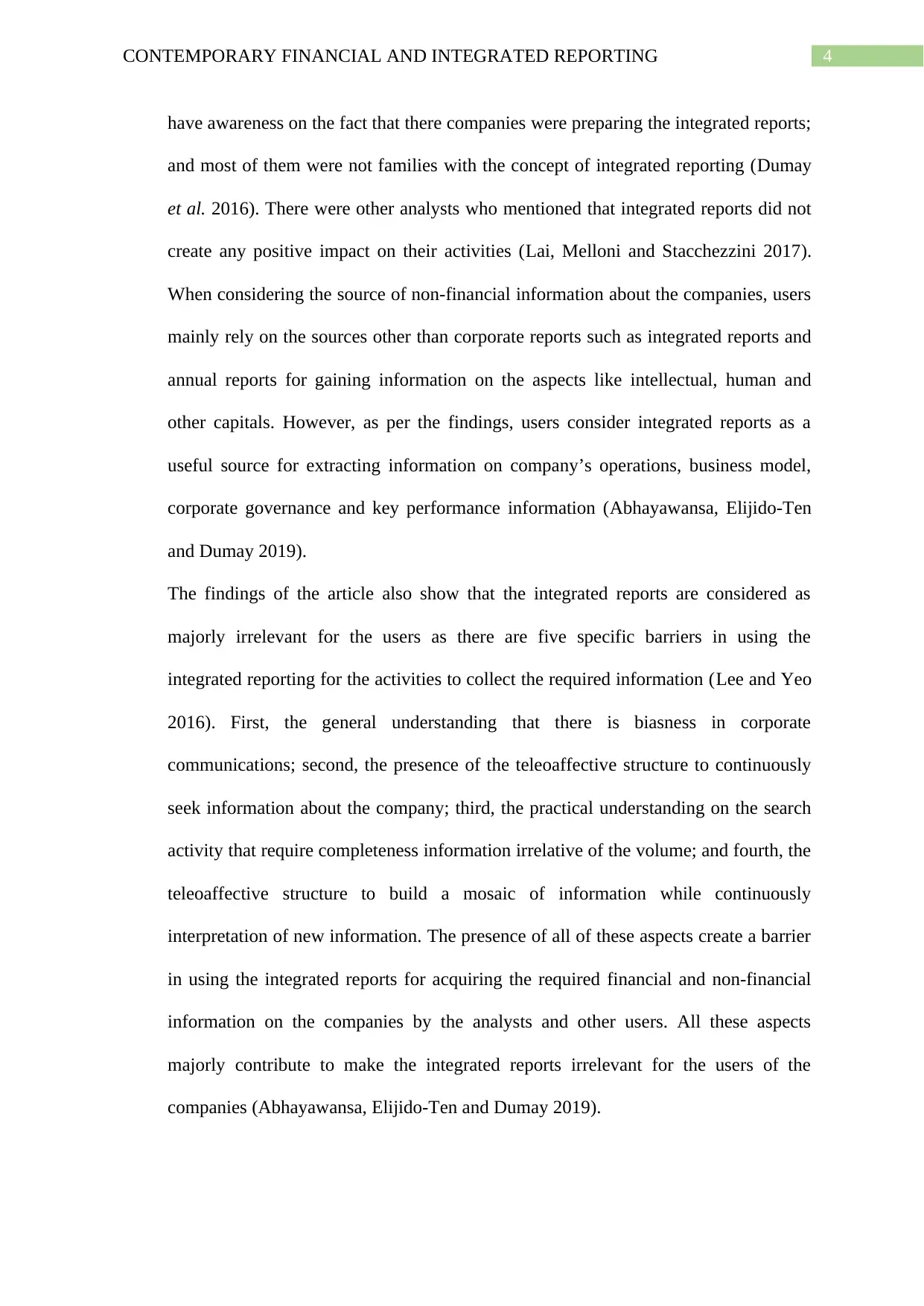
4CONTEMPORARY FINANCIAL AND INTEGRATED REPORTING
have awareness on the fact that there companies were preparing the integrated reports;
and most of them were not families with the concept of integrated reporting (Dumay
et al. 2016). There were other analysts who mentioned that integrated reports did not
create any positive impact on their activities (Lai, Melloni and Stacchezzini 2017).
When considering the source of non-financial information about the companies, users
mainly rely on the sources other than corporate reports such as integrated reports and
annual reports for gaining information on the aspects like intellectual, human and
other capitals. However, as per the findings, users consider integrated reports as a
useful source for extracting information on company’s operations, business model,
corporate governance and key performance information (Abhayawansa, Elijido‐Ten
and Dumay 2019).
The findings of the article also show that the integrated reports are considered as
majorly irrelevant for the users as there are five specific barriers in using the
integrated reporting for the activities to collect the required information (Lee and Yeo
2016). First, the general understanding that there is biasness in corporate
communications; second, the presence of the teleoaffective structure to continuously
seek information about the company; third, the practical understanding on the search
activity that require completeness information irrelative of the volume; and fourth, the
teleoaffective structure to build a mosaic of information while continuously
interpretation of new information. The presence of all of these aspects create a barrier
in using the integrated reports for acquiring the required financial and non-financial
information on the companies by the analysts and other users. All these aspects
majorly contribute to make the integrated reports irrelevant for the users of the
companies (Abhayawansa, Elijido‐Ten and Dumay 2019).
have awareness on the fact that there companies were preparing the integrated reports;
and most of them were not families with the concept of integrated reporting (Dumay
et al. 2016). There were other analysts who mentioned that integrated reports did not
create any positive impact on their activities (Lai, Melloni and Stacchezzini 2017).
When considering the source of non-financial information about the companies, users
mainly rely on the sources other than corporate reports such as integrated reports and
annual reports for gaining information on the aspects like intellectual, human and
other capitals. However, as per the findings, users consider integrated reports as a
useful source for extracting information on company’s operations, business model,
corporate governance and key performance information (Abhayawansa, Elijido‐Ten
and Dumay 2019).
The findings of the article also show that the integrated reports are considered as
majorly irrelevant for the users as there are five specific barriers in using the
integrated reporting for the activities to collect the required information (Lee and Yeo
2016). First, the general understanding that there is biasness in corporate
communications; second, the presence of the teleoaffective structure to continuously
seek information about the company; third, the practical understanding on the search
activity that require completeness information irrelative of the volume; and fourth, the
teleoaffective structure to build a mosaic of information while continuously
interpretation of new information. The presence of all of these aspects create a barrier
in using the integrated reports for acquiring the required financial and non-financial
information on the companies by the analysts and other users. All these aspects
majorly contribute to make the integrated reports irrelevant for the users of the
companies (Abhayawansa, Elijido‐Ten and Dumay 2019).
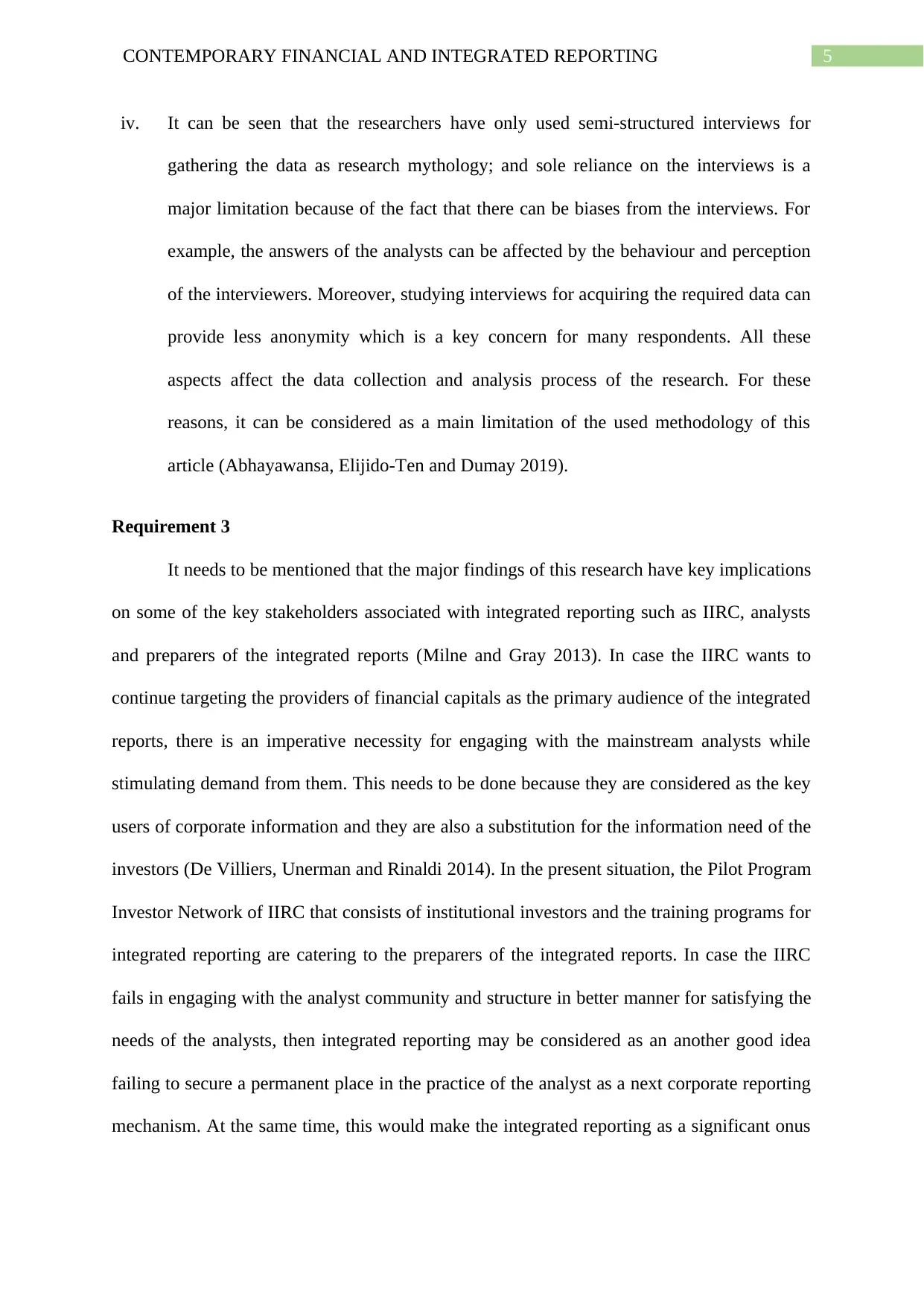
5CONTEMPORARY FINANCIAL AND INTEGRATED REPORTING
iv. It can be seen that the researchers have only used semi-structured interviews for
gathering the data as research mythology; and sole reliance on the interviews is a
major limitation because of the fact that there can be biases from the interviews. For
example, the answers of the analysts can be affected by the behaviour and perception
of the interviewers. Moreover, studying interviews for acquiring the required data can
provide less anonymity which is a key concern for many respondents. All these
aspects affect the data collection and analysis process of the research. For these
reasons, it can be considered as a main limitation of the used methodology of this
article (Abhayawansa, Elijido‐Ten and Dumay 2019).
Requirement 3
It needs to be mentioned that the major findings of this research have key implications
on some of the key stakeholders associated with integrated reporting such as IIRC, analysts
and preparers of the integrated reports (Milne and Gray 2013). In case the IIRC wants to
continue targeting the providers of financial capitals as the primary audience of the integrated
reports, there is an imperative necessity for engaging with the mainstream analysts while
stimulating demand from them. This needs to be done because they are considered as the key
users of corporate information and they are also a substitution for the information need of the
investors (De Villiers, Unerman and Rinaldi 2014). In the present situation, the Pilot Program
Investor Network of IIRC that consists of institutional investors and the training programs for
integrated reporting are catering to the preparers of the integrated reports. In case the IIRC
fails in engaging with the analyst community and structure in better manner for satisfying the
needs of the analysts, then integrated reporting may be considered as an another good idea
failing to secure a permanent place in the practice of the analyst as a next corporate reporting
mechanism. At the same time, this would make the integrated reporting as a significant onus
iv. It can be seen that the researchers have only used semi-structured interviews for
gathering the data as research mythology; and sole reliance on the interviews is a
major limitation because of the fact that there can be biases from the interviews. For
example, the answers of the analysts can be affected by the behaviour and perception
of the interviewers. Moreover, studying interviews for acquiring the required data can
provide less anonymity which is a key concern for many respondents. All these
aspects affect the data collection and analysis process of the research. For these
reasons, it can be considered as a main limitation of the used methodology of this
article (Abhayawansa, Elijido‐Ten and Dumay 2019).
Requirement 3
It needs to be mentioned that the major findings of this research have key implications
on some of the key stakeholders associated with integrated reporting such as IIRC, analysts
and preparers of the integrated reports (Milne and Gray 2013). In case the IIRC wants to
continue targeting the providers of financial capitals as the primary audience of the integrated
reports, there is an imperative necessity for engaging with the mainstream analysts while
stimulating demand from them. This needs to be done because they are considered as the key
users of corporate information and they are also a substitution for the information need of the
investors (De Villiers, Unerman and Rinaldi 2014). In the present situation, the Pilot Program
Investor Network of IIRC that consists of institutional investors and the training programs for
integrated reporting are catering to the preparers of the integrated reports. In case the IIRC
fails in engaging with the analyst community and structure in better manner for satisfying the
needs of the analysts, then integrated reporting may be considered as an another good idea
failing to secure a permanent place in the practice of the analyst as a next corporate reporting
mechanism. At the same time, this would make the integrated reporting as a significant onus
⊘ This is a preview!⊘
Do you want full access?
Subscribe today to unlock all pages.

Trusted by 1+ million students worldwide
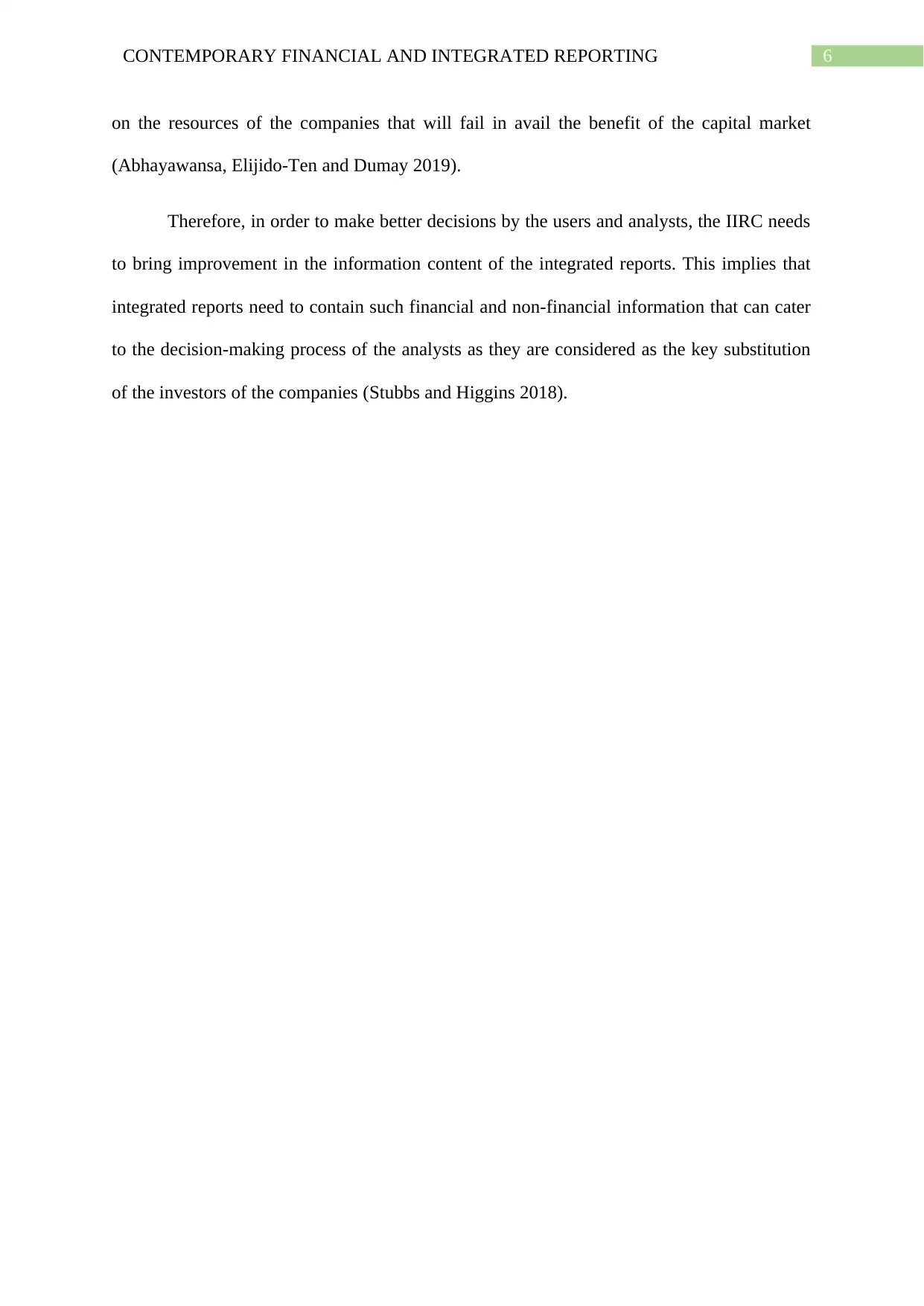
6CONTEMPORARY FINANCIAL AND INTEGRATED REPORTING
on the resources of the companies that will fail in avail the benefit of the capital market
(Abhayawansa, Elijido‐Ten and Dumay 2019).
Therefore, in order to make better decisions by the users and analysts, the IIRC needs
to bring improvement in the information content of the integrated reports. This implies that
integrated reports need to contain such financial and non-financial information that can cater
to the decision-making process of the analysts as they are considered as the key substitution
of the investors of the companies (Stubbs and Higgins 2018).
on the resources of the companies that will fail in avail the benefit of the capital market
(Abhayawansa, Elijido‐Ten and Dumay 2019).
Therefore, in order to make better decisions by the users and analysts, the IIRC needs
to bring improvement in the information content of the integrated reports. This implies that
integrated reports need to contain such financial and non-financial information that can cater
to the decision-making process of the analysts as they are considered as the key substitution
of the investors of the companies (Stubbs and Higgins 2018).
Paraphrase This Document
Need a fresh take? Get an instant paraphrase of this document with our AI Paraphraser
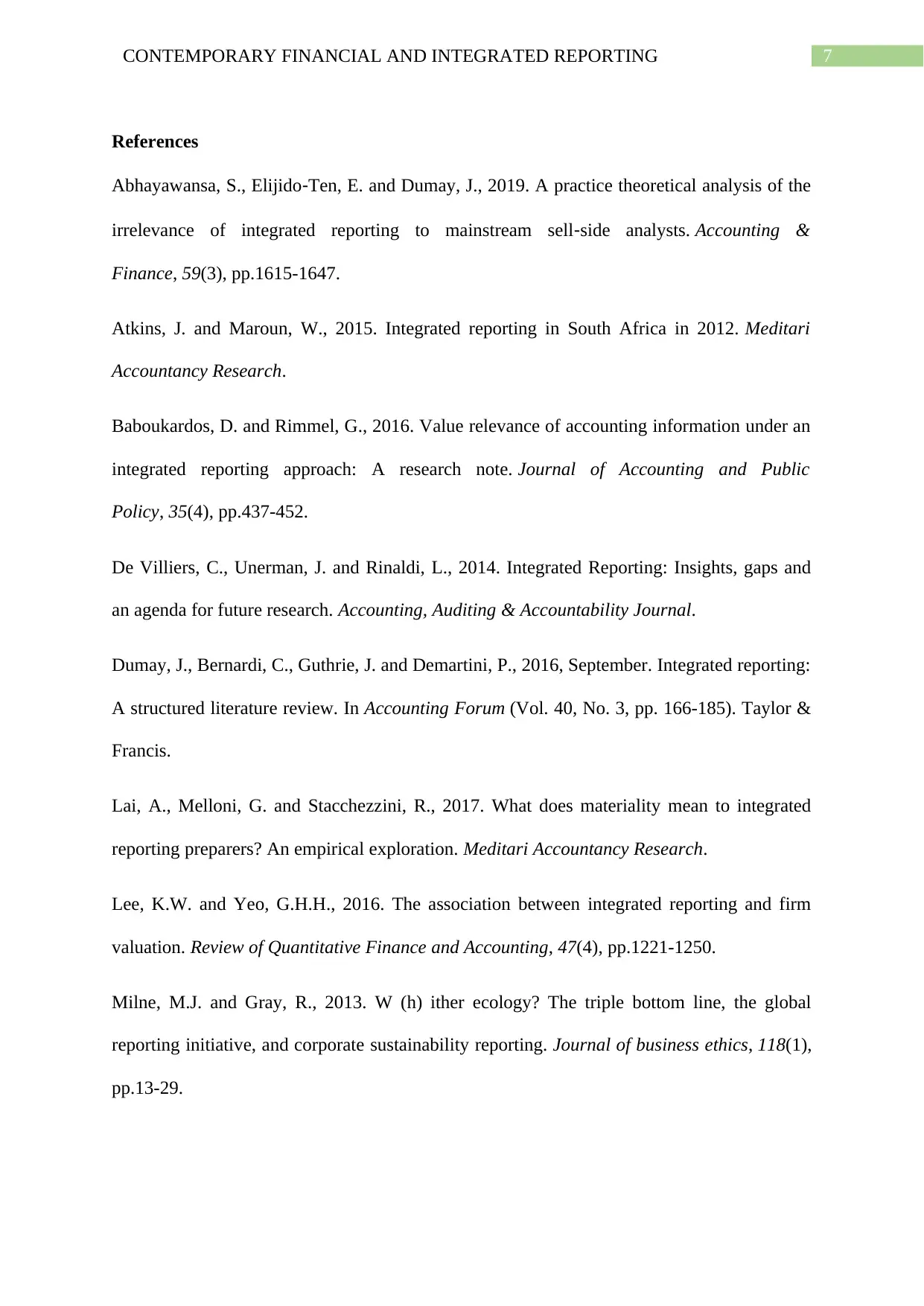
7CONTEMPORARY FINANCIAL AND INTEGRATED REPORTING
References
Abhayawansa, S., Elijido‐Ten, E. and Dumay, J., 2019. A practice theoretical analysis of the
irrelevance of integrated reporting to mainstream sell‐side analysts. Accounting &
Finance, 59(3), pp.1615-1647.
Atkins, J. and Maroun, W., 2015. Integrated reporting in South Africa in 2012. Meditari
Accountancy Research.
Baboukardos, D. and Rimmel, G., 2016. Value relevance of accounting information under an
integrated reporting approach: A research note. Journal of Accounting and Public
Policy, 35(4), pp.437-452.
De Villiers, C., Unerman, J. and Rinaldi, L., 2014. Integrated Reporting: Insights, gaps and
an agenda for future research. Accounting, Auditing & Accountability Journal.
Dumay, J., Bernardi, C., Guthrie, J. and Demartini, P., 2016, September. Integrated reporting:
A structured literature review. In Accounting Forum (Vol. 40, No. 3, pp. 166-185). Taylor &
Francis.
Lai, A., Melloni, G. and Stacchezzini, R., 2017. What does materiality mean to integrated
reporting preparers? An empirical exploration. Meditari Accountancy Research.
Lee, K.W. and Yeo, G.H.H., 2016. The association between integrated reporting and firm
valuation. Review of Quantitative Finance and Accounting, 47(4), pp.1221-1250.
Milne, M.J. and Gray, R., 2013. W (h) ither ecology? The triple bottom line, the global
reporting initiative, and corporate sustainability reporting. Journal of business ethics, 118(1),
pp.13-29.
References
Abhayawansa, S., Elijido‐Ten, E. and Dumay, J., 2019. A practice theoretical analysis of the
irrelevance of integrated reporting to mainstream sell‐side analysts. Accounting &
Finance, 59(3), pp.1615-1647.
Atkins, J. and Maroun, W., 2015. Integrated reporting in South Africa in 2012. Meditari
Accountancy Research.
Baboukardos, D. and Rimmel, G., 2016. Value relevance of accounting information under an
integrated reporting approach: A research note. Journal of Accounting and Public
Policy, 35(4), pp.437-452.
De Villiers, C., Unerman, J. and Rinaldi, L., 2014. Integrated Reporting: Insights, gaps and
an agenda for future research. Accounting, Auditing & Accountability Journal.
Dumay, J., Bernardi, C., Guthrie, J. and Demartini, P., 2016, September. Integrated reporting:
A structured literature review. In Accounting Forum (Vol. 40, No. 3, pp. 166-185). Taylor &
Francis.
Lai, A., Melloni, G. and Stacchezzini, R., 2017. What does materiality mean to integrated
reporting preparers? An empirical exploration. Meditari Accountancy Research.
Lee, K.W. and Yeo, G.H.H., 2016. The association between integrated reporting and firm
valuation. Review of Quantitative Finance and Accounting, 47(4), pp.1221-1250.
Milne, M.J. and Gray, R., 2013. W (h) ither ecology? The triple bottom line, the global
reporting initiative, and corporate sustainability reporting. Journal of business ethics, 118(1),
pp.13-29.
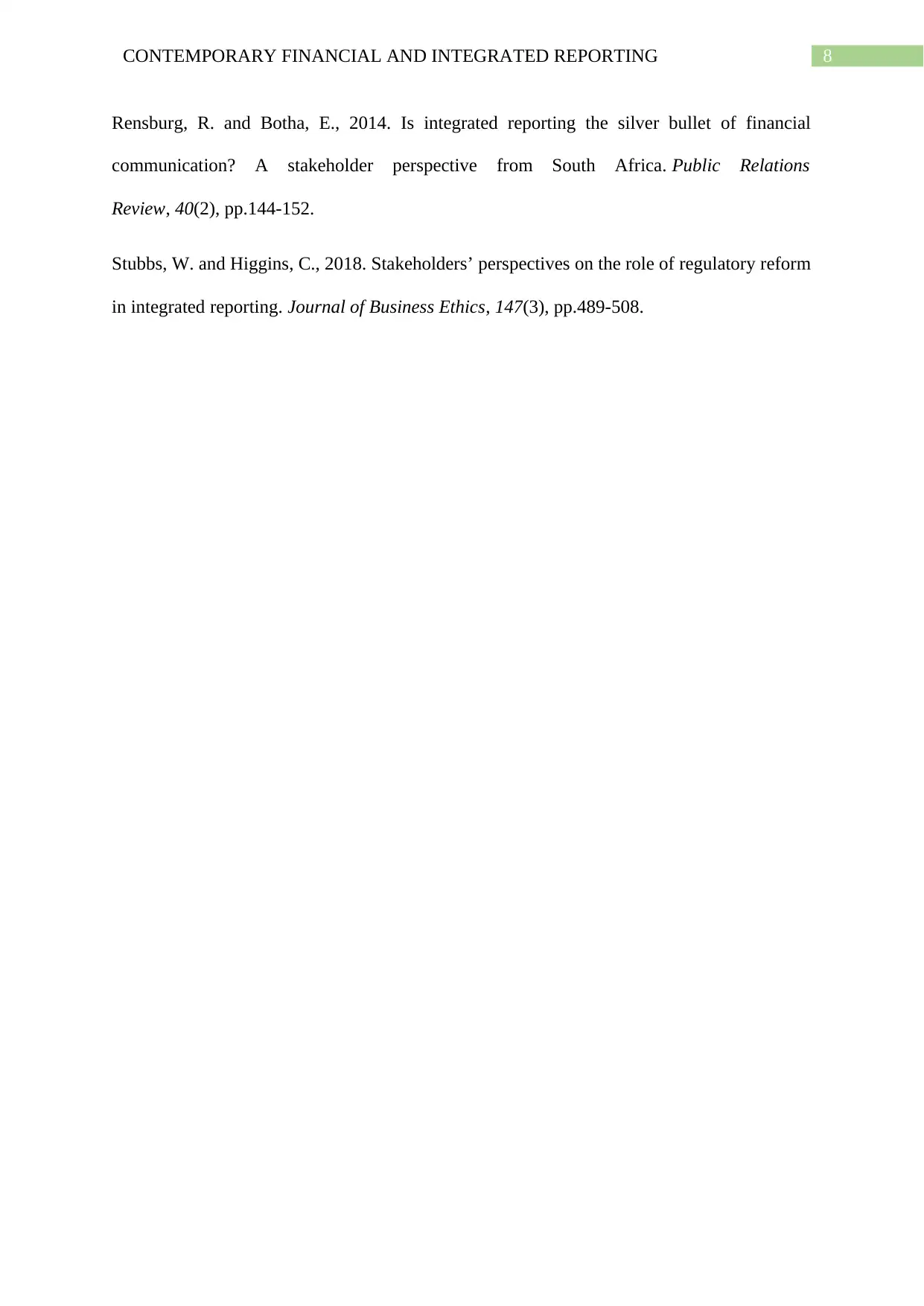
8CONTEMPORARY FINANCIAL AND INTEGRATED REPORTING
Rensburg, R. and Botha, E., 2014. Is integrated reporting the silver bullet of financial
communication? A stakeholder perspective from South Africa. Public Relations
Review, 40(2), pp.144-152.
Stubbs, W. and Higgins, C., 2018. Stakeholders’ perspectives on the role of regulatory reform
in integrated reporting. Journal of Business Ethics, 147(3), pp.489-508.
Rensburg, R. and Botha, E., 2014. Is integrated reporting the silver bullet of financial
communication? A stakeholder perspective from South Africa. Public Relations
Review, 40(2), pp.144-152.
Stubbs, W. and Higgins, C., 2018. Stakeholders’ perspectives on the role of regulatory reform
in integrated reporting. Journal of Business Ethics, 147(3), pp.489-508.
⊘ This is a preview!⊘
Do you want full access?
Subscribe today to unlock all pages.

Trusted by 1+ million students worldwide
1 out of 9
Related Documents
Your All-in-One AI-Powered Toolkit for Academic Success.
+13062052269
info@desklib.com
Available 24*7 on WhatsApp / Email
![[object Object]](/_next/static/media/star-bottom.7253800d.svg)
Unlock your academic potential
Copyright © 2020–2025 A2Z Services. All Rights Reserved. Developed and managed by ZUCOL.





